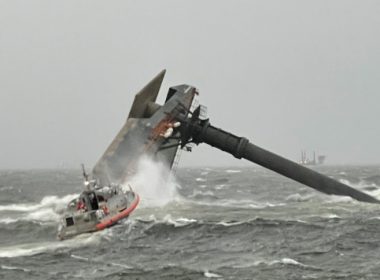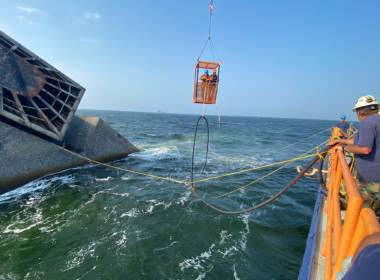Severe winds led to fatal capsizing of liftboat Seacor Power off Louisiana

Severe winds during a thunderstorm led to a loss of stability and ultimately caused the 2021 capsizing of the liftboat Seacor Power, the National Transportation Safety Board (NTSB) said during a public board meeting on Tuesday, October 18.
Of the 19 people aboard the vessel, six died while seven are missing and presumed dead. Six people were rescued by the US Coast Guard and partner agencies.
Seacor Power, which was valued at US$25 million, was a total loss.
On April 13, 2021, Seacor Power, a liftboat supporting offshore work on oil-producing platforms, capsized off the coast of Port Fourchon, Louisiana. Vessel operators reported heavy rain, winds exceeding 80 knots and two- to four-foot (0.6- to 1.2-metre) seas at the time of the capsizing.
Seacor Power was destined for an oil and gas lease block in the Gulf of Mexico and got underway shortly after 12:00 local tome. Sometime after 15:00, the liftboat was overtaken by a rain squall.
The vessel’s mate said a second squall about 10 minutes later caused “white out” conditions. The crew began to lower the vessel’s 265-foot (80-metre) long legs to the seafloor to allow the vessel to ride out the storm.
During the leg-lowering process, the mate turned the vessel into the wind to slow its speed. As the vessel turned, it heeled over and capsized at around 15:57.
A National Weather Service report concluded the area of the capsizing was affected by an “unusually intense thunderstorm wind event.”
The NTSB determined the probable cause of the capsizing of Seacor Power was a loss of stability that occurred when the vessel was struck by severe thunderstorm winds, which exceeded the vessel’s operational wind speed limits.
Contributing to the loss of life on the vessel were the speed at which the vessel capsized and the angle at which it came to rest, which made egress difficult and the high winds and seas in the aftermath of the capsizing, which hampered rescue efforts.
NTSB investigators identified data gaps that prevented the National Weather Service from identifying and forecasting the surface wind magnitudes that Seacor Power encountered. The localised wind conditions could not be detected by weather service radars due to their elevation angles.
As a result, the NTSB recommended the National Weather Service, the Federal Aviation Administration, and the US Air Force work together to assess coastal weather radar sites to determine if it is safe and appropriate to lower radar angles, which could improve the ability to accurately forecast weather conditions.
The NTSB issued three safety recommendations to the US Coast Guard: develop procedures to inform mariners in affected areas whenever there is an outage at a navigational telex broadcasting site; modify restricted-service liftboat stability regulations to require greater stability for newly constructed restricted-service liftboats; and develop procedures to integrate commercial, municipal, and non-profit air rescue providers into sectors’ and districts’ mass rescue operations plans.
The NTSB also reiterated a recommendation to the US Coast Guard to require all personnel employed on vessels in coastal, Great Lakes and ocean service be provided with a personal locator beacon. The NTSB also recommended the Offshore Marine Service Association notify members of personal locator beacons’ availability and value.
“We’ve been waiting five years for the coast guard to implement our recommendation on personal locator beacons — a call to action we’re renewing today for the fourth time,” said NTSB Chair Jennifer Homendy. “Mariners’ safety can’t wait, which is why I’m urging employers to invest in personal locator beacons for their crew. As the Seacor Power tragedy shows, the lifesaving promise of these devices cannot be overstated.”
The first time the NTSB recommended the coast guard require personal locator beacons was following the 2015 sinking of the cargo vessel El Faro in which all 33 crewmembers perished. The NTSB reiterated the recommendation for the first time after the fishing vessel Scandies Rose sank off Sutwik Island, Alaska, in 2019, which killed five people; and again following the 2020 sinking of the fishing vessel Emmy Rose off the coast of Massachusetts, which killed all four crewmembers.
“None of the people aboard El Faro, Scandies Rose, Emmy Rose, or Seacor Power had personal locator beacons,” Homendy said.
The executive summary, probable cause, findings, and safety recommendations are in the report abstract available on the investigation web page. The final report will be published on the NTSB website in several weeks.
The public docket for the investigation includes more than 10,000 pages of factual information, including interview transcripts, a meteorology report, and other investigative materials.






